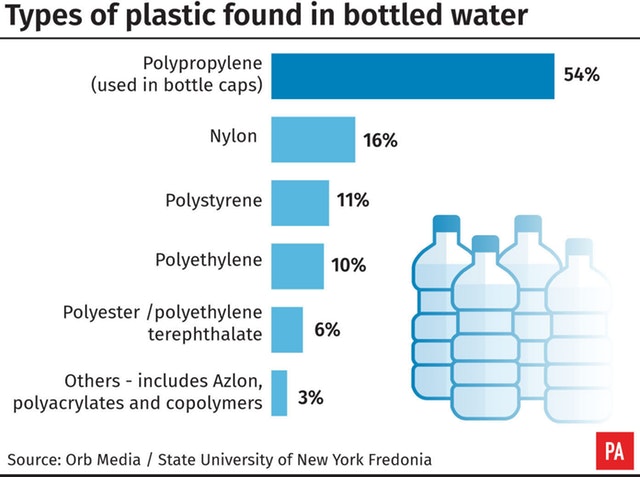Why in news?
A new research has shown the presence of micro-plastic particles in bottled drinking waters.
What are the findings?
- Bottled waters are found to be contaminated with plastic including polypropylene, nylon, and polyethylene terephthalate (PET).
- A single bottle could hold dozens or possibly even thousands of microscopic plastic particles.
- The study finds a global average of 10.4 plastic particles per litre, in the 100 micron or 0.10 millimetre size range.
- The tests also showed a much greater number of even smaller particles which are also likely plastic.
- The global average for these smaller particles is around 300 per litre.
- Water in glass bottles is also found to hold micro-plastics.

Why is the study so significant?
- Bottled water is marketed as the very essence of purity.
- It is in fact the fastest-growing beverage market in the world.
- Bottled water output will soon hit 300 billion litres a year.
- Packaged water is a lifeline for many people worldwide who have no other option for safe drinking water.
- Notably, some 4,000 children die every day from water-borne diseases.
What is the concern with micro-plastics?
- Sources - Micro-plastics are particles that are smaller than 5 millimetres in size.
- They enter the environment as primary industrial products, such as those used in scrubbers and cosmetics.
- It could also enter via urban waste water and broken-down elements of articles discarded by consumers.
- Washing of clothes too releases synthetic microfibres into water bodies and the sea.
- Presence - Micro-plastics escape the filtration and treatment processes for waste water, and end up in sites of nature.
- The durable properties of plastics make them persistent and slow to degrade in the environment.
- Evidently, various studies have found micro-plastics in the oceans, soil, air, lakes, and rivers.
- It thus enters the food chains of even birds, animals and fishes.
- This results in significant global impacts on wildlife, from marine environment pollution.
Is this a human health concern?
- Micro-plastics hold the potential for both bioaccumulation and biomagnification.
- It may thus finally end up in the human body.
- But based on current limited knowledge on the effects, there is little human health concern.
- This is because the human body is well-adapted to dealing with non-digestible particles.
- As much as 90% of micro-plastic that is consumed might be excreted.
- Of the other 10%, some plastic under 150 microns (0.15 millimetres) could enter the gut's lymphatic system.
- It may pass from the bloodstream to the kidneys or liver.
- Notably, the recent bottled water study finds plastics within this range.
- But how plastic behaves in the gut is still based on assumptions from scientific models and not from proper studies.
- Also, the knowledge on the various chemicals present in plastics is limited.
- So the health impact may not yet be clear, but indisputably these are contaminants.
- Research evidence from complementary fields indicates that accumulation of these chemicals can induce or aggravate immune responses in the body.
What does it call for?
- Awareness - Micro-plastic is not directly regulated in bottled water.
- But legislations make it clear that there must be no contaminants.
- It is the government's responsibility to educate people to know what they are drinking and eating.
- Studies - The WHO has come forward to commission a review of the health impact of plastics in water.
- More such studies, as a globally coordinated effort, are necessary to assess the impact of plastics on health.
- India - India has a major problem dealing with plastics, particularly single-use shopping bags.
- These reach dumping sites, rivers and wetlands along with other waste.
- The most efficient way is to control the production and distribution of plastics.
- Banning single-use bags and making consumers pay a significant amount for the more durable ones is a feasible solution.
- Enforcing Solid Waste Management Rules, 2016, requiring segregation of waste materials, will reduce the burden on the environment.
- Waste separation can be done in partnership with the community, and it presents a major employment opportunity as well.
- The very nature of plastics has to be changed from being cheap and disposable to durable, reusable and fully recyclable.
Source: The Hindu
Quick Fact
Bioaccumulation
- Bioaccumulation is the accumulation of substances or chemicals in an organism, and toxins building up in a food chain.
- It occurs when an organism absorbs a substance at a rate faster than that at which it is lost by catabolism and excretion.
Biomagnification
- Biomagnification is the increasing concentration of a toxic substance at successively higher trophic levels in a food chain.
